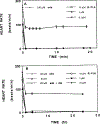Uptake of glucose analogs reflects the rate of contraction of cultured myocytes
- PMID: 10631593
- PMCID: PMC10794912
- DOI: 10.1515/jbcpp.1999.10.4.287
Uptake of glucose analogs reflects the rate of contraction of cultured myocytes
Abstract
The present study demonstrates that: a) adenosine and R-N6-(2-phenylisopropyl)-adenosine (R-PIA, A1 and A3 adenosine receptor agonist) inhibited [3H]deoxyglucose uptake or [3H]3-O-methyl-D-glucose uptake; b) sugar uptake reflects the rate of contraction in cardiac cultures; c) [3H]deoxyglucose uptake or [3H]3-O-methyl-D-glucose uptake are useful quantitative probes for beating rate evaluation. A 25-40% decrease in [3H]deoxyglucose uptake (p < 0.01) was obtained following 13-21 min treatment with 100 microM adenosine together with 1 microM dipyridamole or with 10 microM R-PIA, which inhibited spontaneous contractions. Adenosine (10 microM) attenuated spontaneous beating rate and inhibited approximately 55% of the [3H]deoxyglucose uptake following 22 h treatment (p < 0.01). 1 microM R-PIA also attenuated beating rate following either a short (1 min) or long (24 h) application and decreased [3H]deoxyglucose uptake by 20-30% (p < 0.01) during 0.5-24 h of treatment. A 157 +/- 9% and 205 +/- 11% increase (p < 0.01) in [3H]deoxyglucose uptake was obtained at 27 and 37 degrees C, respectively, compared with the uptake at 17 degrees C, which completely inhibited spontaneous contractions. Similar results [33 +/- 6% (p < 0.01) and 21 +/- 8% (p < 0.05) inhibition in [3H]deoxyglucose uptake] were obtained following 2 and 22 h of carbamylcholine treatment, respectively. This treatment also reduced spontaneous contractions. [3H] 3-O-Methyl-D-glucose uptake also decreased by 31 +/- 12% (p < 0.05) as a result of the arrest of contractions by adenosine. Elevations of 90 +/- 13% and 34 +/- 11% (p < 0.01) in [3H]deoxyglucose uptake were obtained following treatment with isoprenaline after 2 and 22 h application, respectively. It is concluded that adenosine and R-PIA inhibited [3H]deoxyglucose uptake or [3H] 3-O-methyl-D-glucose uptake in rat heart culture and that there is a linkage between the rate of cardiac contractions in culture and sugar uptake.
Figures







Similar articles
-
Adenosine and TNF-alpha exert similar inotropic effect on heart cultures, suggesting a cardioprotective mechanism against hypoxia.Life Sci. 2007 Aug 16;81(10):803-13. doi: 10.1016/j.lfs.2007.06.030. Epub 2007 Jul 21. Life Sci. 2007. PMID: 17764703
-
Differential desensitization of A1 adenosine receptor-mediated inhibition of cardiac myocyte contractility and adenylate cyclase activity. Relation to the regulation of receptor affinity and density.Circ Res. 1990 Aug;67(2):406-14. doi: 10.1161/01.res.67.2.406. Circ Res. 1990. PMID: 2376079
-
Myocardial glucose utilization. Failure of adenosine to alter it and inhibition by the adenosine analogue N6-(L-2-phenylisopropyl)adenosine.Circ Res. 1991 Sep;69(3):791-9. doi: 10.1161/01.res.69.3.791. Circ Res. 1991. PMID: 1873873
-
Characterization of adenosine receptors in intact cultured heart cells.Biochem Pharmacol. 1994 Aug 17;48(4):727-35. doi: 10.1016/0006-2952(94)90050-7. Biochem Pharmacol. 1994. PMID: 8080445 Free PMC article.
-
Coupling of M-cholinoceptors and A1 adenosine receptors in human myocardium.Am J Physiol. 1994 May;266(5 Pt 2):H1951-8. doi: 10.1152/ajpheart.1994.266.5.H1951. Am J Physiol. 1994. PMID: 8203594
Cited by
-
Modulation of cardiac A1-adenosine receptors in rats following treatment with agents affecting heart rate.Mol Cell Biochem. 2002 Feb;231(1-2):107-16. doi: 10.1023/a:1014412814735. Mol Cell Biochem. 2002. PMID: 11952152
-
Glycogen metabolism in rat heart muscle cultures after hypoxia.Mol Cell Biochem. 2003 Dec;254(1-2):311-8. doi: 10.1023/a:1027302021428. Mol Cell Biochem. 2003. PMID: 14674711
-
Mechanism of glycogen supercompensation in rat skeletal muscle cultures.Mol Cell Biochem. 2003 Aug;250(1-2):11-9. doi: 10.1023/a:1024980710799. Mol Cell Biochem. 2003. PMID: 12962138
References
-
- Sokoloff L, Reivich M, Kennedy C, des Rosiers MH, Patlak CS, Pettigrew KD, Sakurada O, Shinohara M. The 14C deoxyglucose method for the measurement of local cerebral glucose utilization: theory, procedure, and normal values in the conscious and anesthetized albino rat. J Neurochem 1977; 28: 897–916. - PubMed
-
- Saje M, Obata K. Stimulus-dependent labeling of cultured ganglionic cell with 4C-deoxyglucose. Brain Res 1981; 212: 435–446. - PubMed
-
- Shainberg A, Pearl R. Activity of muscle cultures measured by 2-deoxy-glucose uptake. Int J Dev Neurosci 1983; 1:267–271. - PubMed
-
- Kennedy C, Des Rosiers M, Fehle FW, Reivich M, Sharp F, Sokoloff L. Mapping of functional neurol pathway by autoradiographic survey of local metabolic rate with 14C deoxyglucose. Science 1975; 187: 850–853. - PubMed
-
- Bogaert J, Maes A, Van de Werf F, Bosmans H, Herregods MC, Nuyts J, Desmet W, Mortelmans L, Marchal G, Rademakers FE. Functional recovery of subepicardial myocardial tissue in transmural myocardial infarction after successful reperfusion: an important contribution to the improvement of regional and global left ventricular function. Circulation 1999; 99: 36–43. - PubMed
Publication types
MeSH terms
Substances
Grants and funding
LinkOut - more resources
Full Text Sources
